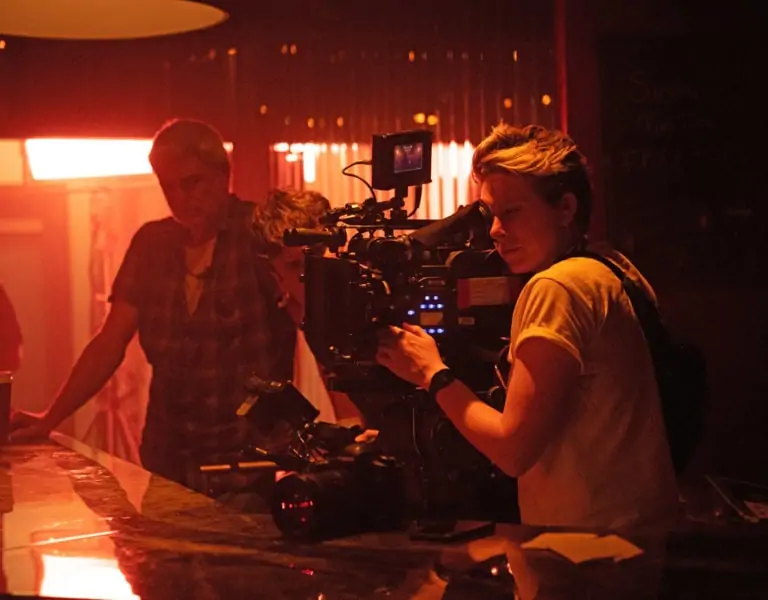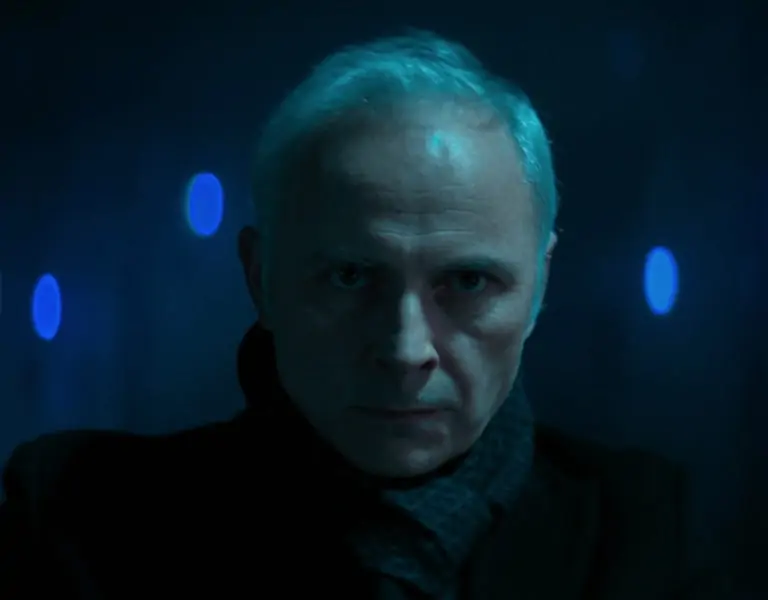ROOTED IN REALITY
Personal memories and tender snapshots of family life are captured with grace and compassion in Minari, a semi-autobiographical story of a Korean American family making brave sacrifices in the quest for a better life.
Lachlan Milne ACS NZCS was wrapping the final day of filming action-adventure Love and Monsters in Queensland when he received the call from his agent, brimming with excitement at the prospect of the Australian cinematographer’s next production. “This is the best thing I’ve read in a while. Please don’t do anything tonight other than read the script for Minari,” they urged.
With its title deriving from the hardy Korean herb that flourishes in the wild, A24 drama Minari follows a Korean American family who relocate from California to try to establish a farm and a better life in 1980s rural Arkansas. Through the heartfelt story of hope, determination, family connection, and culture clash, we see Jacob Yi (Steven Yeun) strive to overcome hurdles in an attempt to achieve the American dream for his wife Monica (Yeri Han) and children David and Anne.
A deeply personal film for writer-director Lee Isaac Chung, many moments in Minari are lifted from his childhood memories. From the lush green surroundings through to the intimate details of family life, fragments of Chung’s early years are portrayed with a rich and magical tenderness, mirrored by the experiences of seven-year-old David (Alan Kim). For instance, when Chung emigrated with his family as a child, his grandmother planted minari seeds, as does David’s quirky and free-spirited grandmother Soonja (Youn Youh-jung) in the film.
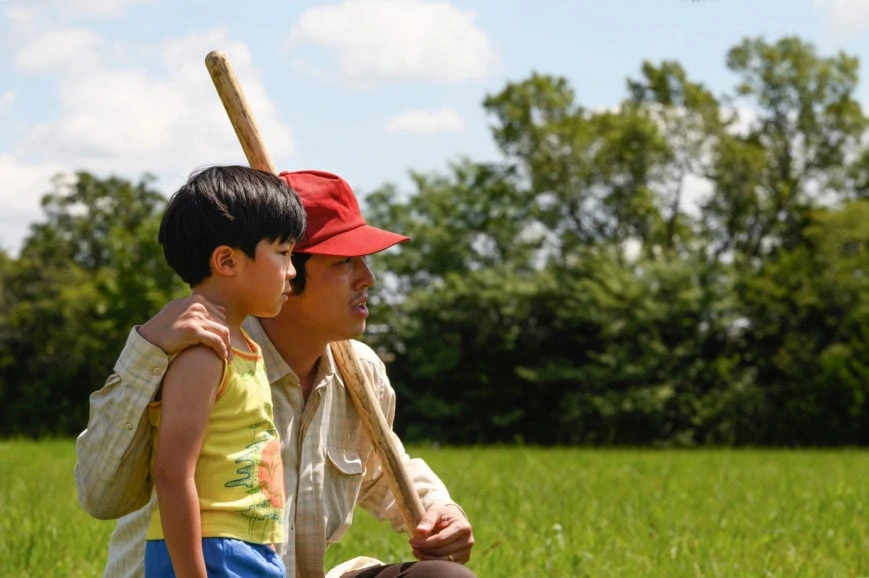
“My agent was right; I immediately fell in love with the story. It was exactly the kind of script I’d been waiting for. Once I had spoken to Isaac about the tone of the film, it was clear he wanted to make it in exactly the way I envisaged shooting it,” says Milne (Hunt for the Wilderpeople, Stranger Things, Little Monsters, Next Goal Wins).
“One of my early questions for Isaac was whether he wanted Minari to feel like a series of snapshot memories. Did he want it to feel how he remembered it as a child? While you don’t really remember the specifics of what it was like to be seven, you remember a tone, an idea or a smell. So that was how we approached making the film – rather than being exactly what happened, we used a bit of creative license in the interest of the story, but really focused on the tone of the scenes.”
I was a real advocate for trying to stay wide and be quite simple photographically whilst treating it as an ensemble performance picture. We would only move to a close-up when it was important for the story.
Lachlan Milne ACS NZCS
Fascinated by the power of editing in the filmmaking process, Milne concentrated on editorial pacing from the initial planning stages and considered how editor Harry Yoon might help shape each scene. “I love approaching shooting from an editorial angle and that really spoke to Isaac too. I felt strongly it should be a single-camera film and after day one, when we saw the natural connection between the cast, I was a real advocate for trying to stay wide and be quite simple photographically whilst treating it as an ensemble performance picture. We would only move to a close-up when it was important for the story.”
Musical concepts from composer Emile Mosseri were available for Milne from the preproduction stage, acting as a valuable creative resource during the formation of the film’s tone and feel and informing some of the framing. “I’ve never worked on a film where I’ve had temp music upfront and it was so helpful,” he says. “Music tells you how you should feel at a certain point. If there’s a montage component to a film, I always ask the director what kind of musical score they have in mind because it can influence how you photograph something.”
Hirokazu Kore-eda’s Shoplifters (2018) and Lee Chang-dong’s Burning (2018) were among the films Milne and Chung drew inspiration from, especially their approach to capturing ensemble performances. “The family aspect and concept of Shoplifters are great, and I love how simple the coverage is. In Burning there are some excellent long one shots or shots people come in and out of. I love giving actors the freedom to act rather than editorially jumping around – keeping them in more of a live observed moment. Isaac agreed, so we both latched onto that same tonal direction.”
BEING RESOURCEFUL
Filmed over 25 days in July 2019, in Tulsa, Oklahoma, the crew worked during peak summer and temperatures in the high 30s. Most of the action plays out inside the trailer – the family’s new home – or on the farmland they have bought. “The budget didn’t allow for sets to be built, so all shots in the trailer were filmed in the belting sun in an actual trailer on the farm,” says Milne.
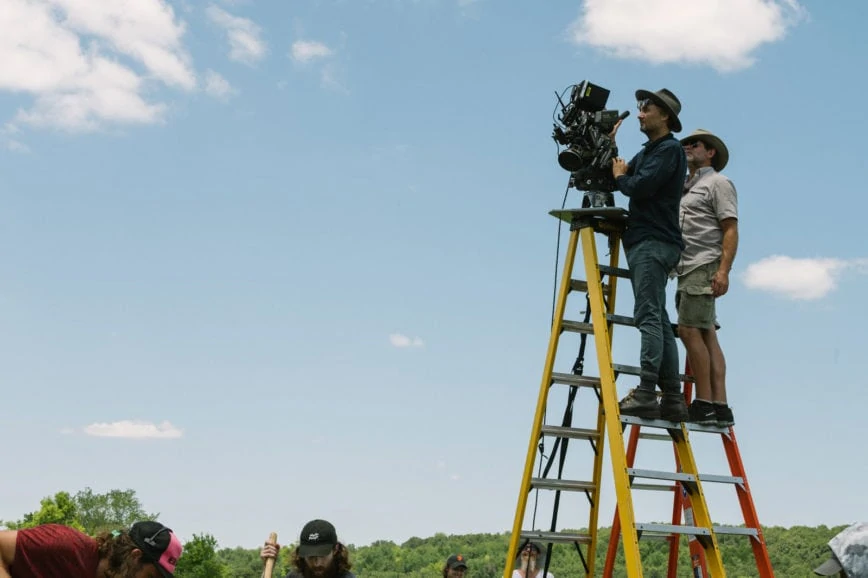
“Like any independent film, the main challenges are time and money, so you must be resourceful and clever. I was surrounded by such a willing and incredibly dedicated small crew. Within my exceptional camera department, I worked with brother and sister focus puller/loader team Jon and Jamie Roman for the first time. They were so supportive and worked unbelievably hard, they deserve to be recognised for their effort.”
Production designer Yong Ok Lee began the preparations and search for the perfect period trailer two weeks prior to Milne’s four-week pre-production. As Minari is a mid-1980s drama and much of the film would be shot in the trailer, it had to be period specific whilst still looking relatively new. “Yong, who is South Korean by birth, dressed up the vintage trailer we purchased to look authentic. Many of my South Korean friends who were around Isaac’s age when the film is set commented on Yong’s production design and how the detailing is quintessentially Korean, helping ground and legitimise the film,” says Milne.
I also chose to rely on a lot of practical lighting because I wanted the trailer’s interior to have a warmer, homely feel to contrast with how brutal and exposed the exterior day scenes were.
Lachlan Milne ACS NZCS
The cinematographer spoke with Chung at length about how best to shoot as wide as possible to maximise the additional width their chosen aspect ratio of 2.39 offered. When capturing wide shots in the trailer – which had fixed walls and only two access points – there was little room for kit. Milne relied on a lot of practical lighting and often positioned the camera in the doorway to achieve the desired visual outcome.
“I also chose to rely on a lot of practical lighting because I wanted the trailer’s interior to have a warmer, homely feel to contrast with how brutal and exposed the exterior day scenes were. I wasn’t going to control the lighting of any exterior shots as I wanted it to feel as harsh and hot as it was, to help sell the trial and torment Jacob’s putting himself through to try to create a better life for his family,” he adds.
Gaffer Steve Mathis (Dawn of the Planet of the Apes, Romeo + Juliet, Moulin Rouge) was a “wonderful collaborator” during this process. “He has worked on huge budget movies, but we knew this would be a much simpler and more modest lighting package. Steve embraced the challenge and presented so many great ideas for the fixtures that would suit the scale of the production including fixing LiteGear bi-colour light ribbon in prac lights and underneath cabinetry in the trailer.
“I can’t speak highly enough of LED technology – the bi-colour fixtures are so small, can be battery-powered, rewired and hidden inside lamp shades if the lamps aren’t bright enough which was a real lifesaver. Colour contrast is a great emotive tool for cinematographers, especially when working with practical lighting in house locations on a 1980s period film like this and using interior fluoro tubes, tungsten domestic bulbs and sodium exterior lights.”
Wanting the trailer home to feel more soothing than the harsher, more bleached exterior shots, Milne discussed his vision with Fotokem colourist David Cole and created two LUTs – an exterior LUT with lifted blacks and the colour pulled down slightly and an interior LUT with the highlights pulled down, with softer contrast and more warmth.
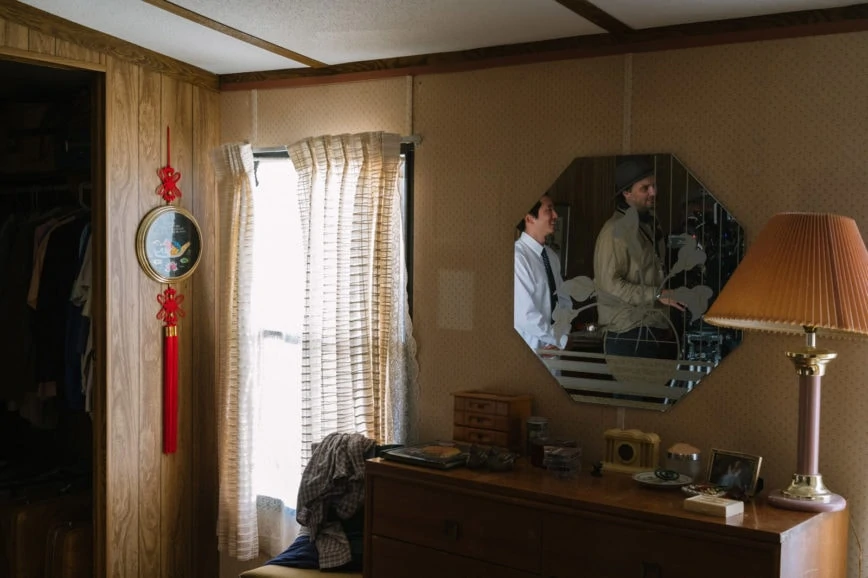
“These were used as a starting point for my grading conversations with Dave, who takes a wonderful story-centred approach to calibrating. We’d have conversations about what we wanted a scene to feel like and why it was shot in a certain way and he would interpret that conversation in his work.”
Due to the number of scenes playing out inside the confines of the trailer, Milne wanted to open the film up as much as possible in the exterior sequences in the lush green landscapes, bathed in scorching sunshine. “This gives the audience a bit of breathing space, an idea of scale and scope, highlighting the mammoth and almost impossible task lying ahead for Jacob. You see this never-ending expanse of field in contrast to the man who is trying to plough it and develop his farm. As it was so hot the quality of the light was photographically quite unfortunate, but I felt if we started to shape or diffuse anything it would become a different movie – too sculpted and polished.”
CAPTURING HONEST PERFORMANCES
Milne shot with his tried and trusted camera of choice – the ARRI Alexa Mini – and Panavision PVintage prime lenses. “I knew most of the film would sit in the 24mm to 35mm range and the PVintage lens family offers some great focal lengths. It’s fast, older glass, and was perfect for the feel we were going for. I also like the availability and speed of lenses when shooting 2.39 – my favourite aspect ratio – which was important to factor in when I knew I would have to work and light quickly given the time constraints,” he explains.
“The close focus nature of anamorphic lenses also doesn’t really get you where you need to be when you’re filming children who often do unpredictable things. That’s what’s so wonderful about those more candid scenes, especially if you’re shooting handheld.”
By filming select moments handheld, Milne wanted to be freer in his movement to capture honest performances, in turn making Minari feel more observed, raw and alive rather than overly composed. “I try not to limit actors, particularly kids, if I can avoid it because then you do the film a disservice, even more so if you’re trying to convey honesty. You need to be able to be reactive and adaptive, so for many of the scenes David was in I would just follow him and whatever he did.”
Aiming to add a unique sense of perspective to every shot, Milne incorporates depth with care. If the actors are in the background, he tries to introduce a foreground element to act as separation. Minari is essentially from David’s point of view and one of his main attributes is his how small he is, so Milne wanted the fact David is nearer the ground to factor in the visuals. “I wanted to bring the concept of snapshots from a child’s perspective into the film, often shooting from a low angle and through the grass, immersed in the surroundings.”
The more limited time with talented child actor Alan Kim compared to the adult cast was also factored into the prep. “He’s in just about every scene. If we scheduled a 12-hour day, we might only get six hours with Alan, so we needed to think carefully about blocking some scenes, positioning the adults at one end of the trailer and him at the other end, off camera.”
Minari is predominantly in Korean and is the first foreign language film Milne has shot. It required him to consider his approach to filming dialogue that was not in his native tongue. “I thought it might be an obstacle that I had only read the script in English and would then be shooting some scenes handheld, bouncing between two people having a conversation in Korean. Eventually it didn’t matter quite as much as anticipated, and I went on an instinctual physicality of the scenes, knowing what the tone should be from having seen the script written in English. I would listen for key words I understood so I would know when to cut between the characters.”
The experience of filming one “beautiful” and dialogue-heavy sequence between Jacob and Monica, after they visit the Korean grocer to sell their produce, was a powerful lesson in the art of performance for Milne. “It wasn’t necessarily about the photography. I just loved operating that scene and being the closest person to the talented cast, watching it happen live and then seeing how it ended up editorially in the final cut.”
For Minari’s crescendo – an emotionally charged fire sequence – Milne was aware he would only have a small window of time in which to shoot and felt handheld would allow him to film a variety of angles quickly and untethered.
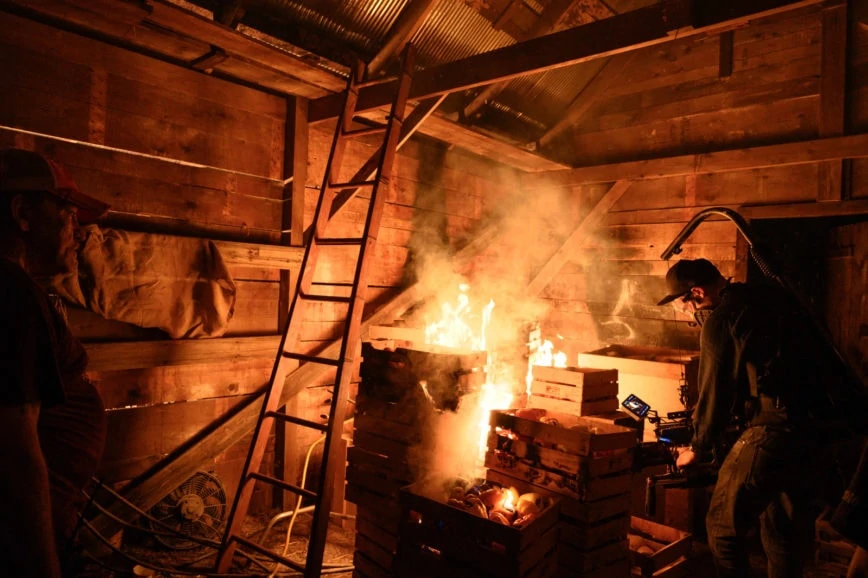
“I love the combination of visuals, music, editing and the scale of that scene and what it means for the characters. The biggest challenge was convincing everyone we should burn the barn down for real as this wasn’t a big budget film,” he says. “Isaac and I really pushed to do it in camera rather than through visual effects as it was the film’s emotional climax – the tragic moment when two people sit in front of an inferno and watch everything they invested their time in going up in flames. We didn’t want people to be underwhelmed by that sequence and knew the actors would benefit from it being real rather than if they were in front of a blue screen.”
The burning barn scene was filmed over two nights – the first night devoted to capturing the off-fire footage, performances and shots of the car lit to appear as if there was a fire off camera right. The interior fire scenes were shot on the second night using flame bars and controlled fire before capturing exterior shots of the barn being torched to the ground.
I started to hear what sounded like crying so I walked up to [Steven Yeun and Yeri Han], turned around and they were both in tears – pure, natural emotion.
Lachlan Milne ACS NZCS
“I wanted to be able to use the one lens and race around as the fire grew, filming from a variety of angles, so I shot handheld with a 29mm lens to keep it wide. The fire started out relatively calm but escalated quickly and I kept rolling, filming Yeri and Steven and bringing them further away from the fire for safety.
“We then pulled back to a wide shot and captured this beautiful moment when they’re in silhouette in front of the towering inferno. I started to hear what sounded like crying so I walked up to them, turned around and they were both in tears – pure, natural emotion. As we shot that scene towards the end, everybody was so invested, it felt like a real release for them which makes that scene even more powerful. This was a valuable lesson in filmmaking – if you can present as realistic a scenario as possible it only benefits the production. It was a real gift to the performance for them to be able to actually see the burning barn.”
The magic of Minari also lies in its simplicity and “what we didn’t have”, according to the cinematographer. “I love how restrained we were in the coverage of the film. If you’re brave, committed and all on the same page about how you want the film to feel, then I don’t think additional coverage is necessary. I try to stay true to that in my work and be clear about the coverage because sometimes less is a lot more. And because this was a small budget film, we didn’t use cranes or multiple camera coverage which is one of the beauties of Minari – how honest it feels and how simple and pure it is photographically.”
